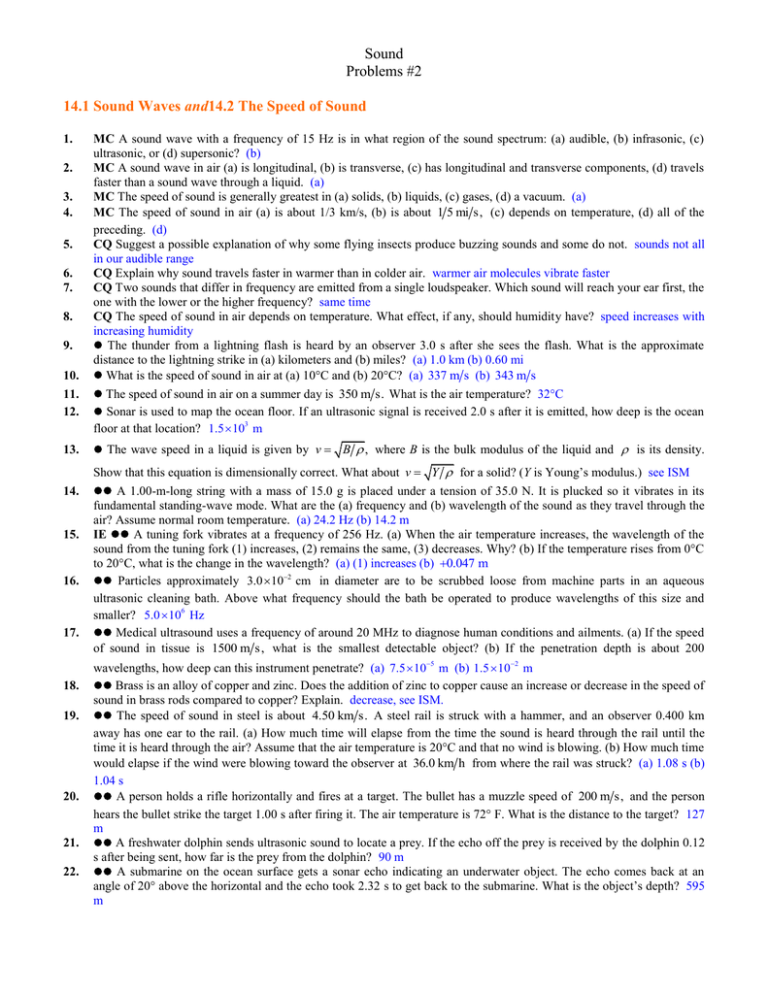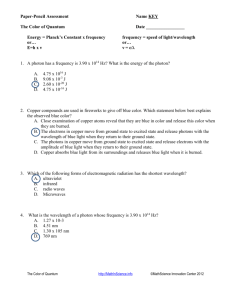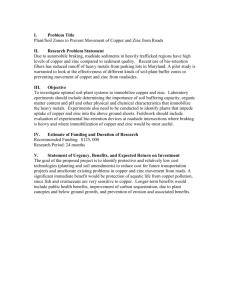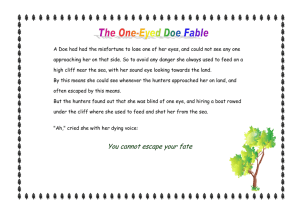Sound Problems #2 14.1 Sound Waves and14.2 The Speed of
advertisement

Sound Problems #2 14.1 Sound Waves and14.2 The Speed of Sound 1. 2. 3. 4. 5. 6. 7. 8. 9. 10. 11. 12. 13. MC A sound wave with a frequency of 15 Hz is in what region of the sound spectrum: (a) audible, (b) infrasonic, (c) ultrasonic, or (d) supersonic? (b) MC A sound wave in air (a) is longitudinal, (b) is transverse, (c) has longitudinal and transverse components, (d) travels faster than a sound wave through a liquid. (a) MC The speed of sound is generally greatest in (a) solids, (b) liquids, (c) gases, (d) a vacuum. (a) MC The speed of sound in air (a) is about 1/3 km/s, (b) is about 1 5 mi s, (c) depends on temperature, (d) all of the preceding. (d) CQ Suggest a possible explanation of why some flying insects produce buzzing sounds and some do not. sounds not all in our audible range CQ Explain why sound travels faster in warmer than in colder air. warmer air molecules vibrate faster CQ Two sounds that differ in frequency are emitted from a single loudspeaker. Which sound will reach your ear first, the one with the lower or the higher frequency? same time CQ The speed of sound in air depends on temperature. What effect, if any, should humidity have? speed increases with increasing humidity The thunder from a lightning flash is heard by an observer 3.0 s after she sees the flash. What is the approximate distance to the lightning strike in (a) kilometers and (b) miles? (a) 1.0 km (b) 0.60 mi What is the speed of sound in air at (a) 10°C and (b) 20°C? (a) 337 m s (b) 343 m s The speed of sound in air on a summer day is 350 m s. What is the air temperature? 32°C Sonar is used to map the ocean floor. If an ultrasonic signal is received 2.0 s after it is emitted, how deep is the ocean floor at that location? 1.5 103 m The wave speed in a liquid is given by v B , where B is the bulk modulus of the liquid and is its density. Show that this equation is dimensionally correct. What about v Y for a solid? (Y is Young’s modulus.) see ISM 14. 15. 16. 17. 18. 19. 20. 21. 22. A 1.00-m-long string with a mass of 15.0 g is placed under a tension of 35.0 N. It is plucked so it vibrates in its fundamental standing-wave mode. What are the (a) frequency and (b) wavelength of the sound as they travel through the air? Assume normal room temperature. (a) 24.2 Hz (b) 14.2 m IE A tuning fork vibrates at a frequency of 256 Hz. (a) When the air temperature increases, the wavelength of the sound from the tuning fork (1) increases, (2) remains the same, (3) decreases. Why? (b) If the temperature rises from 0°C to 20°C, what is the change in the wavelength? (a) (1) increases (b) 0.047 m Particles approximately 3.0 102 cm in diameter are to be scrubbed loose from machine parts in an aqueous ultrasonic cleaning bath. Above what frequency should the bath be operated to produce wavelengths of this size and smaller? 5.0 106 Hz Medical ultrasound uses a frequency of around 20 MHz to diagnose human conditions and ailments. (a) If the speed of sound in tissue is 1500 m s , what is the smallest detectable object? (b) If the penetration depth is about 200 wavelengths, how deep can this instrument penetrate? (a) 7.5 105 m (b) 1.5 10 2 m Brass is an alloy of copper and zinc. Does the addition of zinc to copper cause an increase or decrease in the speed of sound in brass rods compared to copper? Explain. decrease, see ISM. The speed of sound in steel is about 4.50 km s. A steel rail is struck with a hammer, and an observer 0.400 km away has one ear to the rail. (a) How much time will elapse from the time the sound is heard through the rail until the time it is heard through the air? Assume that the air temperature is 20°C and that no wind is blowing. (b) How much time would elapse if the wind were blowing toward the observer at 36.0 km h from where the rail was struck? (a) 1.08 s (b) 1.04 s A person holds a rifle horizontally and fires at a target. The bullet has a muzzle speed of 200 m s, and the person hears the bullet strike the target 1.00 s after firing it. The air temperature is 72° F. What is the distance to the target? 127 m A freshwater dolphin sends ultrasonic sound to locate a prey. If the echo off the prey is received by the dolphin 0.12 s after being sent, how far is the prey from the dolphin? 90 m A submarine on the ocean surface gets a sonar echo indicating an underwater object. The echo comes back at an angle of 20° above the horizontal and the echo took 2.32 s to get back to the submarine. What is the object’s depth? 595 m 23. 24. 25. 26. The size of your eardrum (the tympanum; see Fig. 1 in Insight 14.2 on p. 475) partially determines the upper frequency limit of your audible region, usually between 16000 Hz and 20000 Hz. If the wavelength is on the order of twice the diameter of the eardrum and the air temperature is 20° C, how wide is your eardrum? Is your answer reasonable? 8.6 103 m to 1.1 10 2 m; yes IE On hiking up a mountain that has several overhanging cliffs, a climber drops a stone at the first cliff to determine its height by measuring the time it takes to hear the stone hit the ground. (a) At a second cliff that is twice the height of the first, the measured time of the sound from the dropped stone is (1) less than double, (2) double, or (3) more than double that of the first. Why? (b) If the measured time is 4.8 s for the stone dropping from the first cliff, and the air temperature is 20°C, how high is the cliff? (c) If the height of a third cliff is three times that of the first one, what would be the measured time for a stone dropped there to reach the ground? (a) (1) less than double (b) 1.0 102 m (c) 8.7 s A bat moving at 15.0 m s emits a high-frequency sound as it approaches a wall that is 25.0 m away. Assuming the bat continues straight toward the wall, how far away is he when he receives the echo? The temperature in the bat cave is a cool 8.0°C. 22.9 m Sound propagating through air at 30°C passes through a vertical cold front into air that is 4.0°C. If the sound has a frequency of 2500 Hz, by what percentage does its wavelength change in crossing the boundary? 4.5% Answers 18. From Table 14.1, the speed of sound in copper is 3500 m/s, while the speed of sound in zinc is 3200 m/s. So adding zinc to copper will decrease the speed of sound in the alloy, i.e., brass. Insight 14.2





